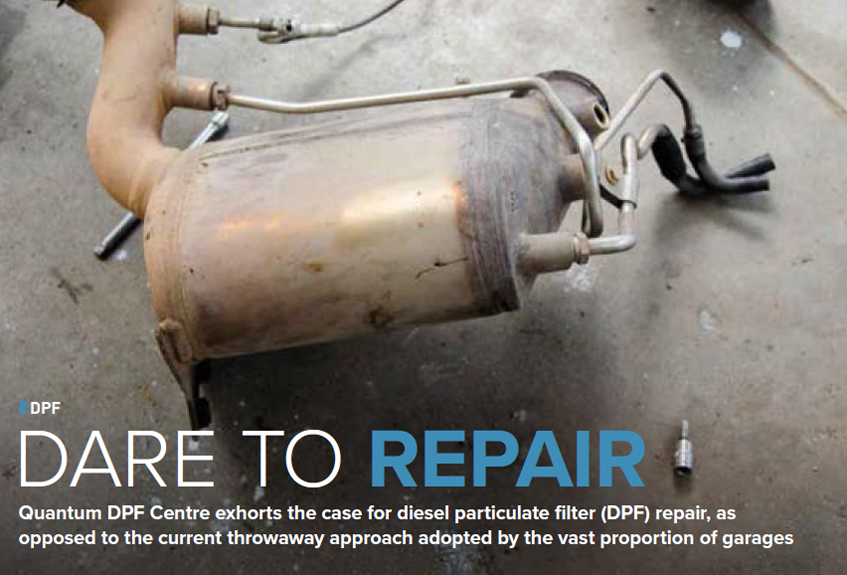Efective DPF diagnostics is fundamental to providing a right-first-time solution. By assessing the mileage and information gathered by diagnostics it should be possible to determine whether a DPF is blocked with soot, for which a forced regeneration could be suŒcient, or ash, in which case the DPF requires removal and cleaning.
Whilst driving style and, in particular, urban usage is the biggest cause of filter blockage, it’s also vital through detailed diagnosis to eliminate other causal issues such as sensor failure or EGR problems.
THE LAST RESORT
The blocking of DPF’s are a source of continued problems for a high percentage of diesel drivers. Normally, diŒculties are brought about by the vehicle being used mainly within the urban environment and therefore stopping the passive regeneration process from operating.
Owners expect their garage to resolve the problem but DPF knowledge is lacking in many garages and therefore the default answer is to just replace the filter. This is particularly common in the main dealer environment and is wrong, unless the internal monolith is broken up. Replacing the DPF when not needed represents a significant and unnecessary cost to the customer.
DPF’s can be regenerated or cleaned either on or oƒ the vehicle. If the filter is significantly blocked or has high ash content then the only way to clean and restore it is by ‘oƒ the vehicle’ cleaning.
KNOWING YOUR PARTICLES
Soot and ash are fundamentally diƒerent materials but they both accumulate in the DPF. Soot can normally be removed from the DPF through regeneration, which burns it and leaves the ash behind.
Ash, on the other hand, is incombustible and can only be removed from the DPF by cleaning ‘oƒ the vehicle’.
Owners and indeed garages often think a regeneration is an automatic quick fix, only to find the customer returns after a few days or weeks with the same issue. This is indicative of not thoroughly diagnosing the problem.
The regeneration process can be aided by the application of specialist fluids that work as a catalyst to aid and accelerate the burn-oƒ process, usually through lowering the temperature at which the trapped soot burns.
REGENERATION PERILS
Everyone is aware that diesel emissions and their particulate matter is carcinogenic. There is concern in the industry that carrying out a static regeneration of a DPF (as opposed to driving at highway speeds) has further serious health implications. The emissions during regeneration are particularly hazardous and, when done in the static environment, are not being adequately dispersed.
There is plenty of evidence of regenerations being carried out close to public areas and, quite incredibly, even within the workshop. It’s also of great concern when static regenerations are carried out at customers’ houses, clearly without a risk assessment as to public access and ventilation.
The ability to do static regenerations is a diagnostic trick and, although there appears to be no specific legislation that currently stops them taking place, it is potentially in violation of the Clean Air Act if performed in an unsecured environment.
To highlight the lack of realisation as to the dangers of the emissions, it’s becoming regular practice to stand at the back of the car and video the regeneration or cleaning process for social media purposes!
The simple question is to ask : Would I let my kids stand next to a car having a static regeneration?” Garage owners clearly have a duty of care to protect their employees and the public. Therefore, they should carry-out and document a procedure for DPF regeneration and decide whether static regeneration is appropriate in the environment in which it is to take place.
“Owners expect their garage to resolve the problem but DPF knowledge is lacking in many garages”
DPF – Facts and guidance
- Passive regeneration requires no specific action from the owner, other than trying to build into their journey plans some regular higher speed extra-urban journeys
- If the DPF soot levels are excessively high and/or the vehicle mileage exceeds 80,000 then it’s highly likely that the ash levels are high too
- If the diagnostic checks show no mechanical or electronic failure then a forced regeneration will need to be carried out to try and reduce soot levels within the DPF
- It’s highly likely a blocked DPF can be fully cleaned and restored; however, if the DPF has a damaged or broken core then the filter must be replaced
- Emissions from forced regenerations are harmful and must be completed away from public areas
- If soot levels are excessively high, or there is high ash content, then forced regeneration will not work




